Detective Comics #27 (1939)
by Bill Finger & Bob Kane
You might have heard of this obscure hero called Batman.
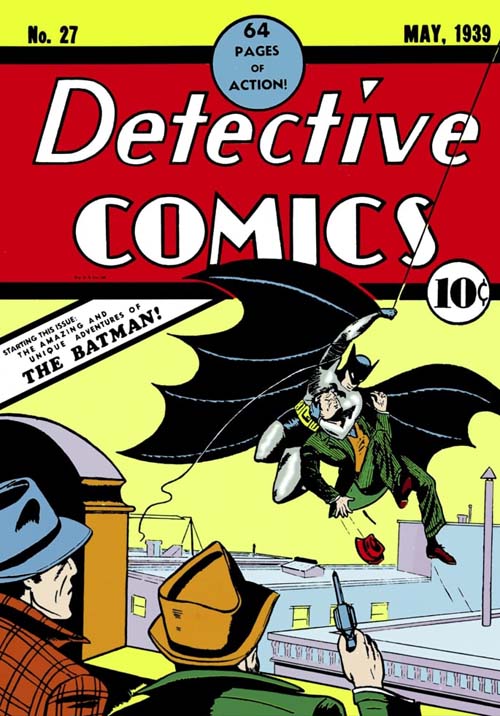
Sorry, it’s “The Bat-Man”. Notice the hyphen is in the title page; I assume the reason he was immediately known as Batman is that it’s how it’s spelled on the cover.
Also, notice Bob Kane manages to be the only one to sign. He will insist to be the only creator of Batman for years, with poor Bill Finger… who by most accounts did most of the work needed to make Batman stand out… needing to wait forever for proper recognition.
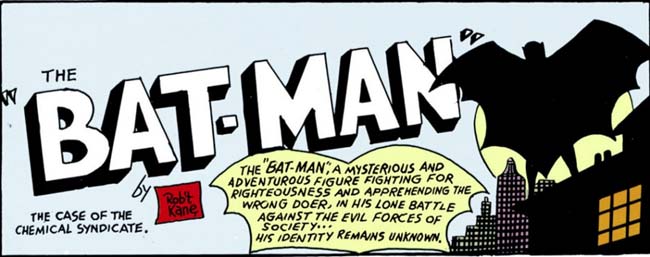
Both Bruce Wayne and Commissioner Gordon debut in the very first panel.
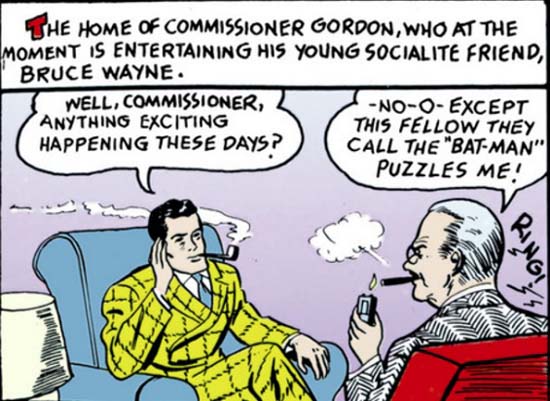
So… in the 30s, did the police really invite random civilians to come along during investigations?
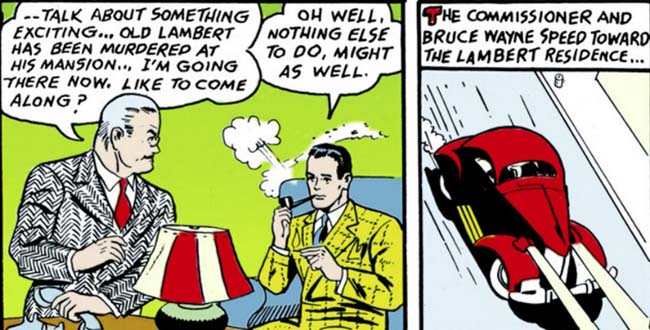
The victim’s son is a prime suspect, but there may be more to the story.

As they are interrogating the son, an associate of the victim decides to call. Notice that the balloon showing the call is shaped like a thought balloon; the style wasn’t entirely settled this early in the Golden Age, so you see this kind of stuff sometimes.
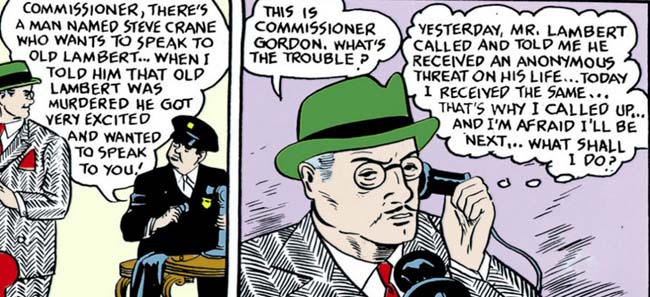
Immediately after the Commissioner hangs up, the business associate is murdered.

But he doesn’t get very far away, because The Bat-Man is already there!
I’m not entirely sure of the logistics here… they murder the business associate immediately after he hands up the phone with Gordon, and Bruce Wayne is there with the commissioner… but he’s ALREADY there with the bad guys!? How close did the business associate live to the victim!?!?
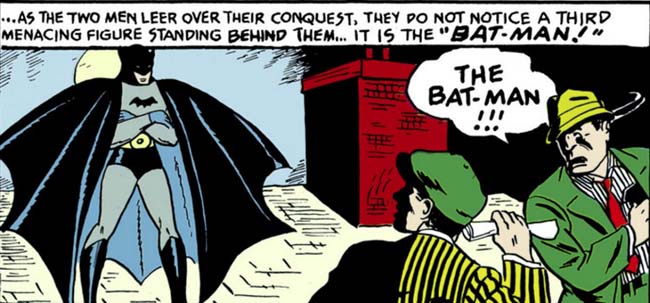
The Bat-Man roughs them up quickly. Unlike most early heroes, he doesn’t even quip: in fact he doesn’t open his mouth during the entire sequence.
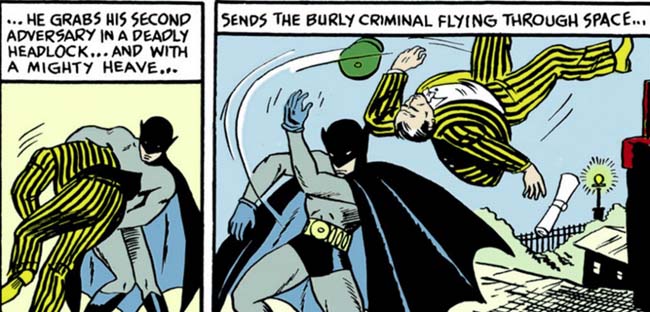
After reading the papers he confiscated from the murderers, he drives away in the very first Batmobile… although of course it doesn’t have the name yet. The first true Batmobile isn’t that far off, however, debuting in Detective Comics #35.
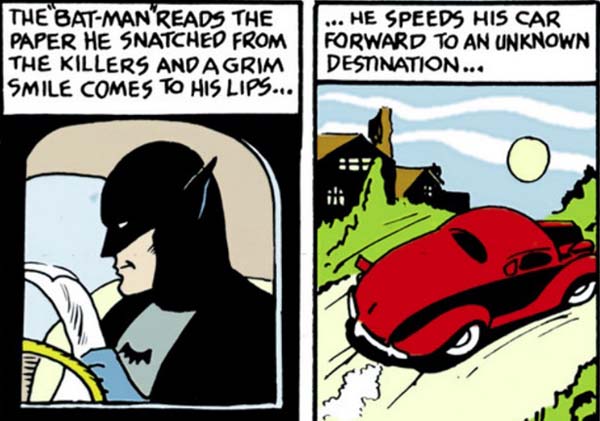
The other business associates are doing just fine.
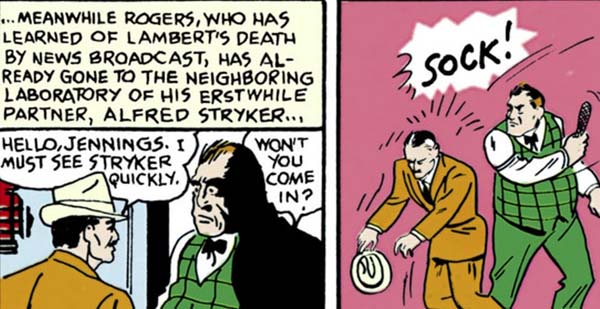
You would expect Batman’s first adventure to be very grounded. And it is, when compared to other heroes, but it still includes a mad scientist of sorts!
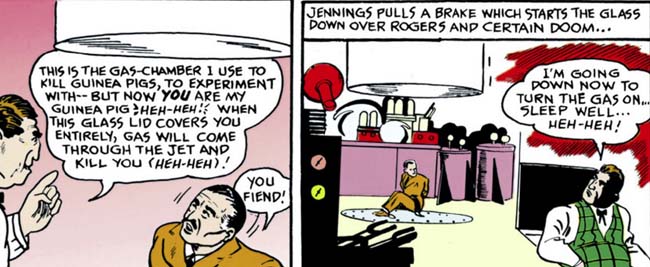
Naturally The Bat-Man is not far behind. Notice that while he already has his Utility Belt™, it doesn’t include everything he needs: he still has to borrow a nearby wrench.
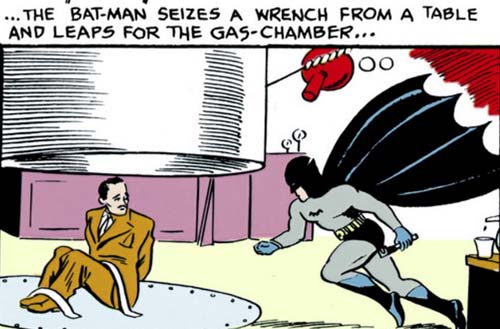
It’s been 84 years since this story. Has Batman ever saved the day with a handkerchief a second time?
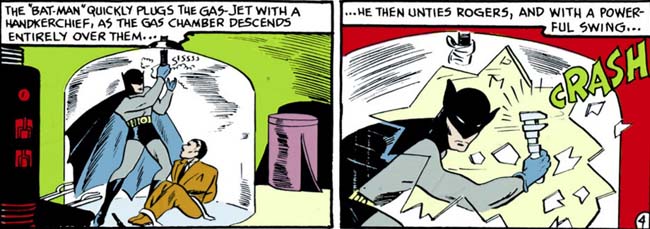
As far as first adversaries go, Jennings isn’t particularly interesting.

But notice The Bat-Man is STILL not talking during the entire outing.

Jennings wasn’t working alone: his boss is the REAL villain.
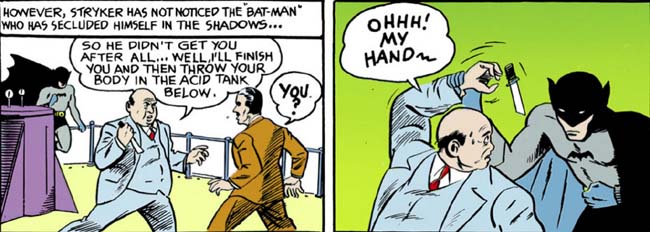
I kind of preferred when The Bat-Man didn’t talk.
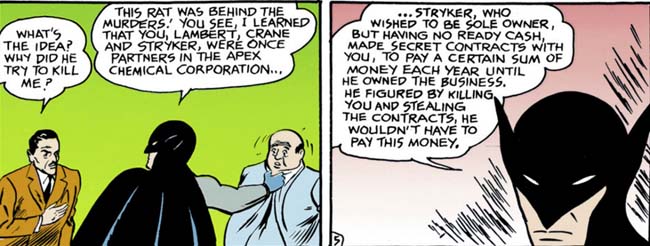
They guy tries to shoot The Bat-Man, who doesn’t see to show any remorse whatsoever murdering him.
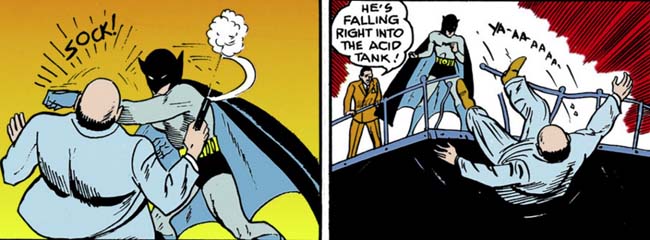
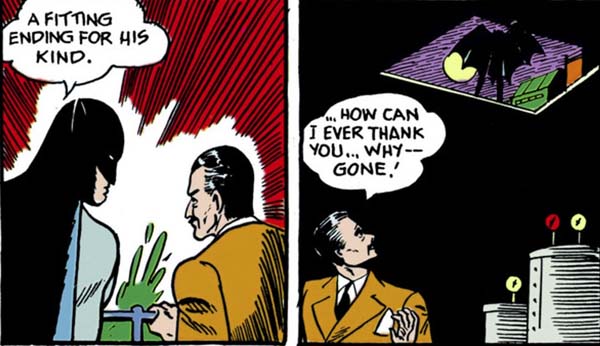
And so we end with The Bat-Man going back home.
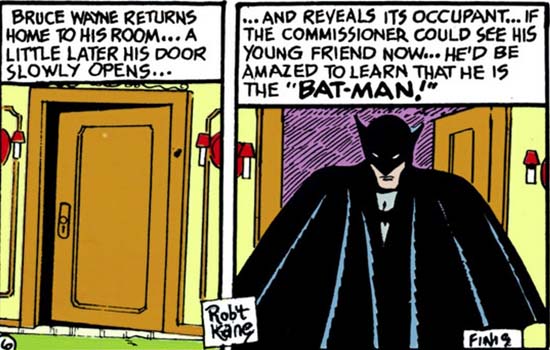
That’s it! Only six pages, for a total of 55 panels.
Not much more to say about the plot, other than it’s WIDELY believed to be a complete ripoff of nearly identical to Shadow story “Partners of peril” published in 1936.
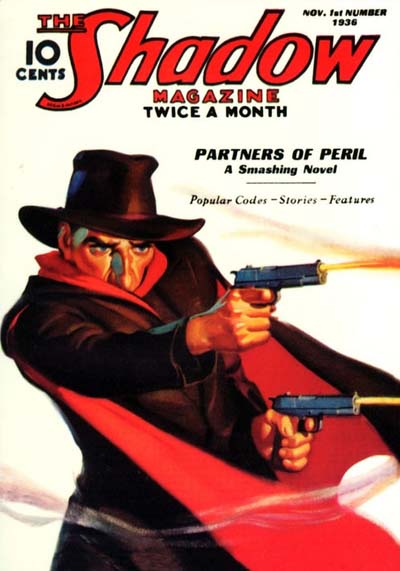
ESPECIALLY if you look at the illustrations of that story. Not only it includes the gas tank…
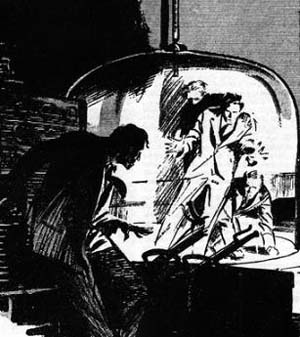
…but more importantly, Batman is CLEARLY walking through the same scene!
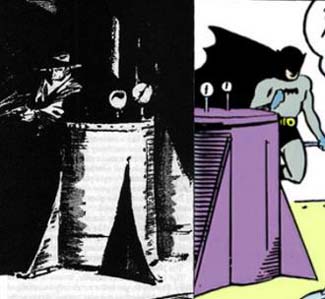
(credit to the images and to the analysis to theshadowstrikes.tumblr.com)
I could not find anywhere the current price for a copy of the 1936 Shadow magazine.
By contrast, the highest price ever paid for a copy of Detective Comics #27 was 1.5 million dollars in 2020. It’s estimated that there are no more than 5 copies of the same quality around today.
Much like Action Comics, Detective Comics was also still an anthology series… as the cover promises, there are “64 pages of action” here.
Excluding several one-page comics (mostly humor), there are NINE stories besides Batman!!!

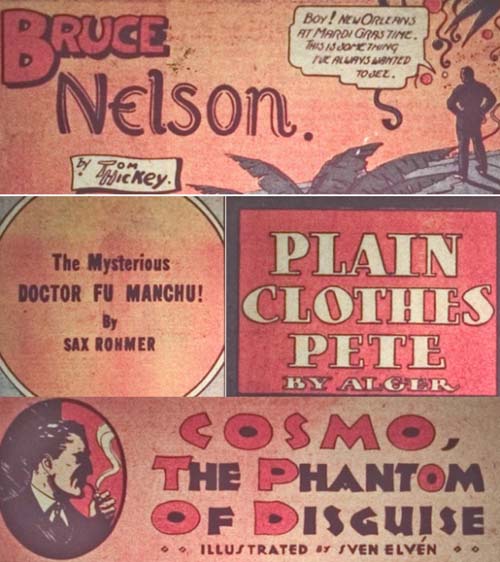
They are all at most 6 pages, like Batman’s… except the Slam Bradley one that reaches 9 pages, and which is the last story to be featured in the issue.
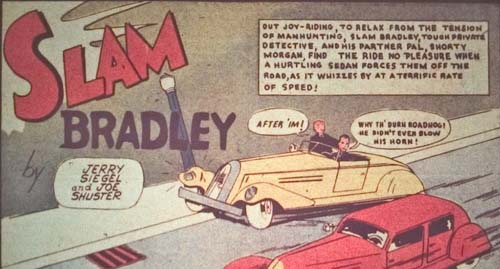
Historical significance: 10/![]()
HE’S BATMAN.
Silver Age-ness: 0/![]()
Very nearly unrecognizable.
Does it stand the test of time? 5/![]()
If the story really IS a copy of the Shadow story, it’s an entire book condensed in six pages… and it really, REALLY shows because everything is in quite the rush, even by Golden Age standards.
What DOES still stand, however, is the atmosphere! Batman not talking during much of the investigation really helps selling the mood.
How close is this to the modern character? 4/![]()
Well… he still has a long way to go, doesn’t he? There are no gadgets, no tragic backstory, no Gotham City (introduced in Batman #4 in 1940), no Bat-Cave (introduced in Batman #12 in 1942) and even his code against killing won’t arrive for a long time.
But he’s already brooding in his own way, he’s using the shadows and the silence… you can definitely see the seeds of what will change the Bat-Man into Batman.
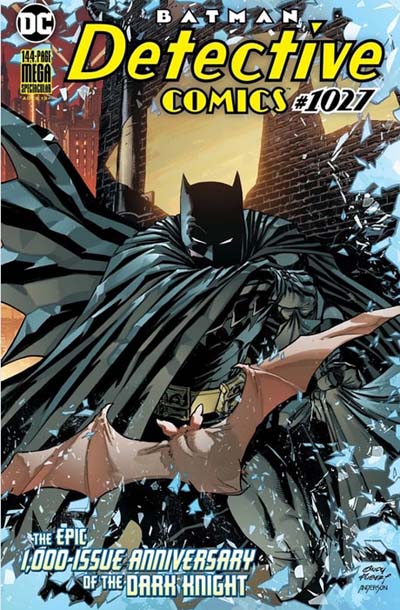
But honestly this doesn’t feel complete without tackling Batman’s origin story, so… let’s do that, it’s not like it’ll take much time!
Detective Comics #33 (1939)
by Bill Finger & Bob Kane
It’s amazing that Batman went 7 issues before he gets an origin story. Even more amazing that it’s not the main feature: it’s just a 2-page story before the main one.
Notice from the cover that his looks already resemble the traditional Batman look way more.
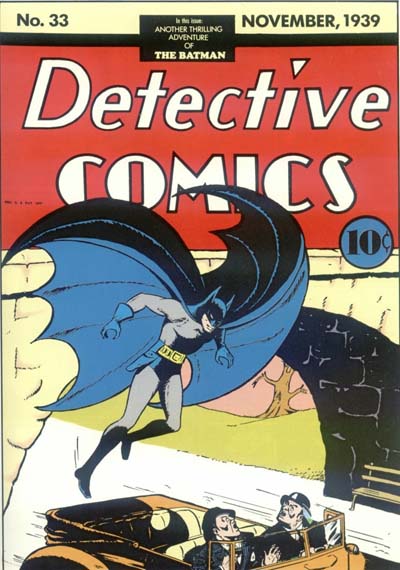
Batman’s father gets a name in his very first appearance, while his mother will have to wait until 1948’s “Batman #47”.
Also, the murder of the parents was “some fifteen years ago”. So Batman was originally conceived as beginning his career in his mid-20s? A little younger than I assume everyone imagines Batman.
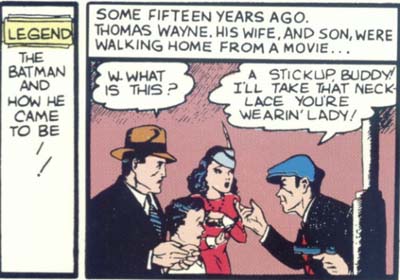
The origin will, of course, go through countless variations. The fact that Thomas Wayne tried to confront his assassin is there right from the original, as is the fact that he’s shot first.
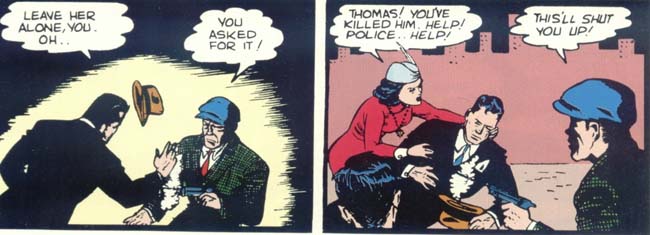
Golden Age heroes RARELY talk about their origins (Superman didn’t even know HIS origin for the vast majority of it!); I’m guessing this must’ve been quite a shock for the readers of the time, even if the violence wasn’t exactly lacking.
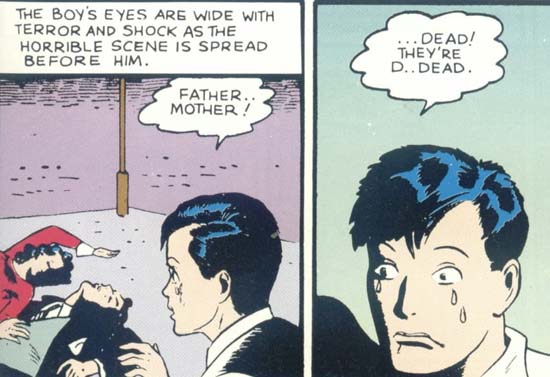
The young Bruce swearing to dedicate his life to crimefighting still hits today. Notice the scene being illuminated by a candle; this is 5 issues before the introduction of Robin, who will get his own oath under candlelight.
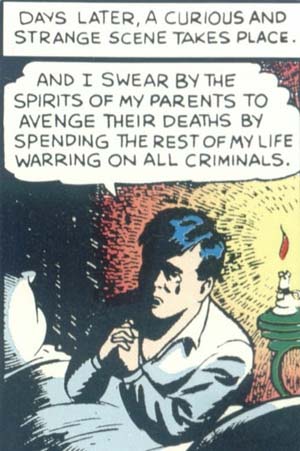
Entire storylines and movies have been dedicated to the journey of Bruce Wayne to learn everything he needed to become Batman. The Golden Age needs two panels!!!

The famous “superstitious cowardly lot” scene comes when Bruce is wondering what kind of disguise he should take.
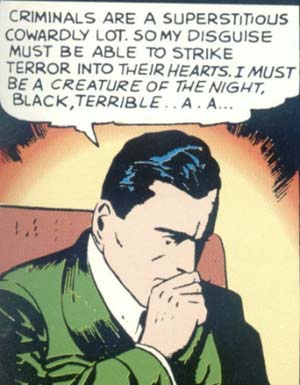
Immediately followed by the nearly as iconic “I shall become a bat” moment, and that’s how the 2-page story ends.
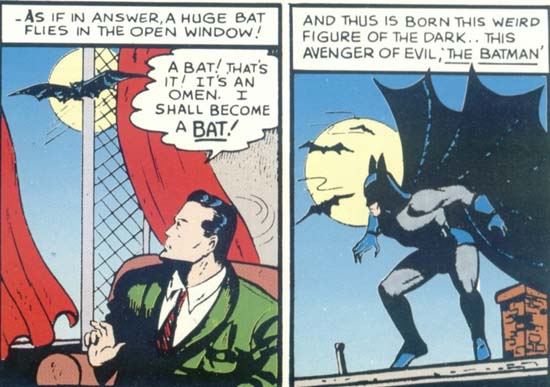
I really appreciate the fact that, in the original, the bat just flies through the window… a lot of retellings go through the extreme of having the bat smash through it, which I always found ridiculously hilarious. It’s a regular bat, not a monster!!!
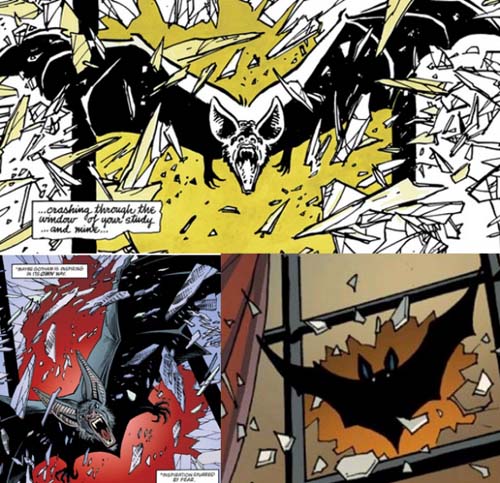
The scene has been parodied countless times. My favorite is probably Batman #256, which dedicates several vignettes to alternative identities in a very tongue-in-cheek joke.
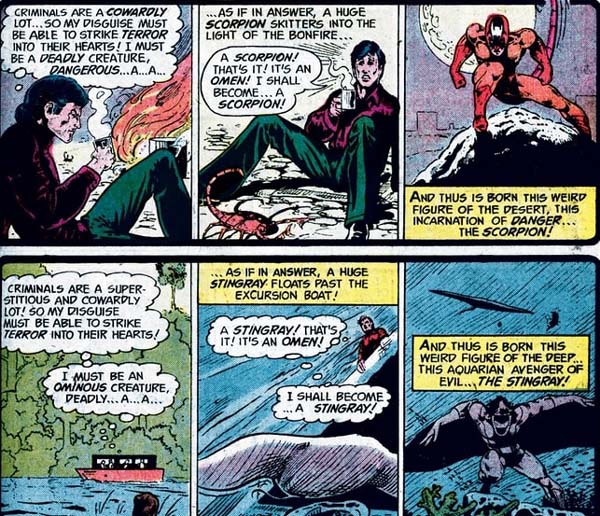

Also: don’t trust anyone who complains that Batman got silly in the Silver Age. Because what’s the main story of the same issue where we learn his very tragic and very human origin?
Batman having to deal with dirigibles with death rays that destroy cities…
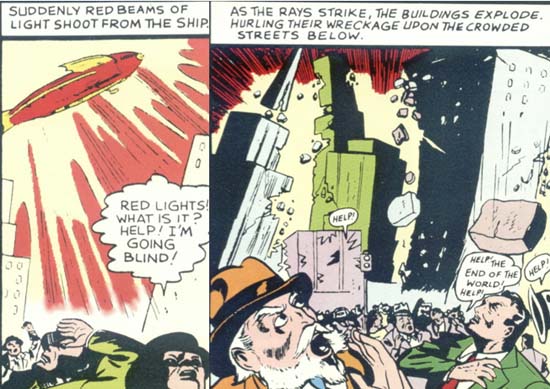
…unleashed by a guy who thinks he’s Napoleon.

So don’t complain about a Batman that is not “realistic”.
